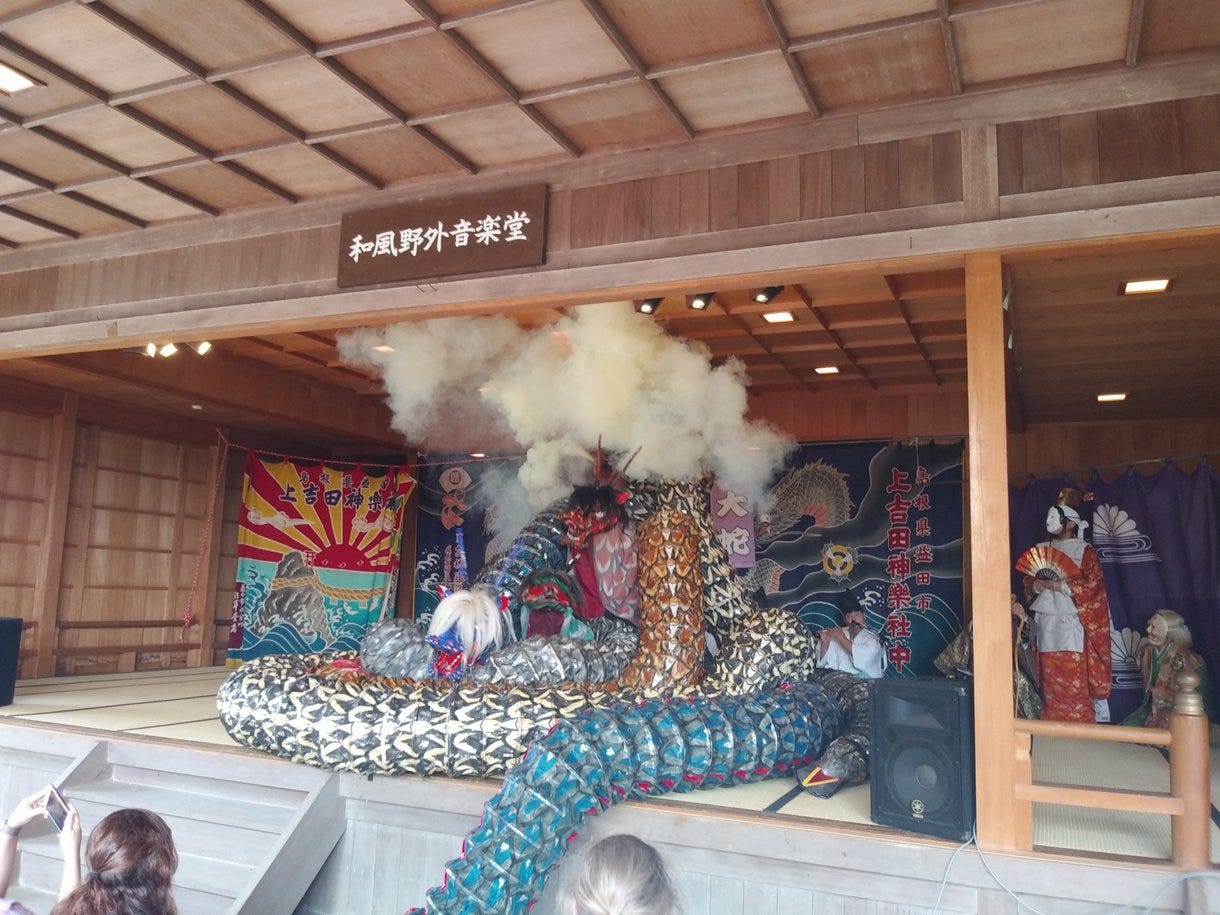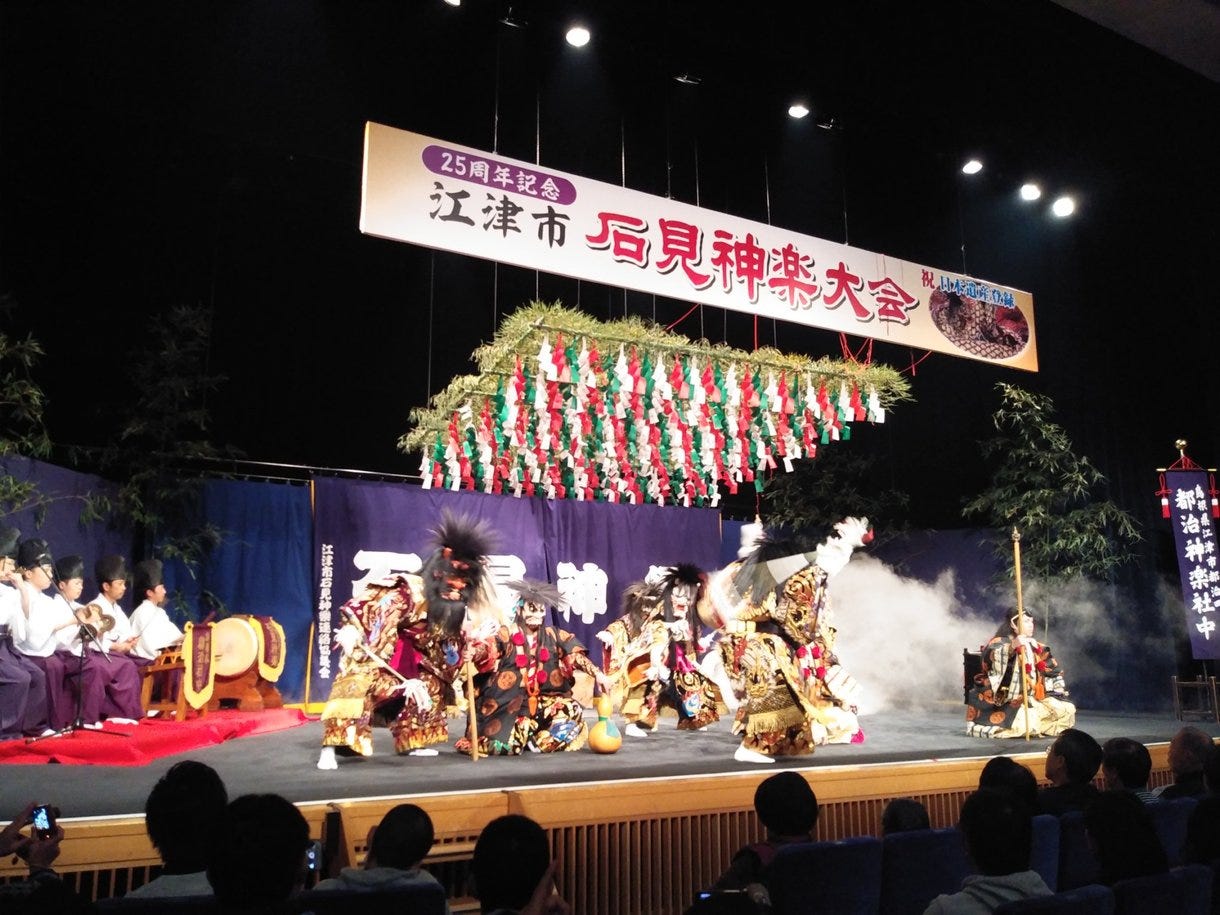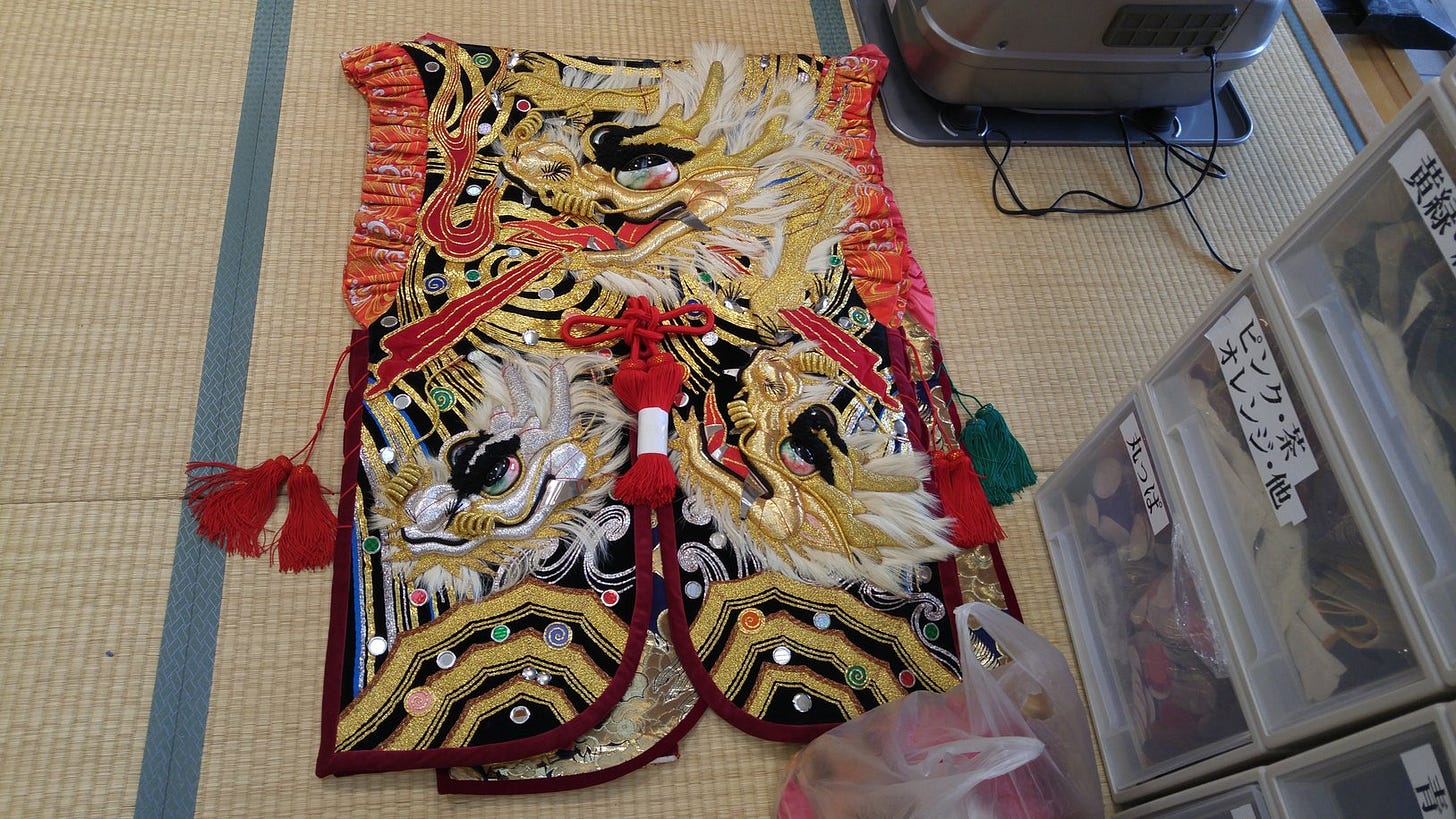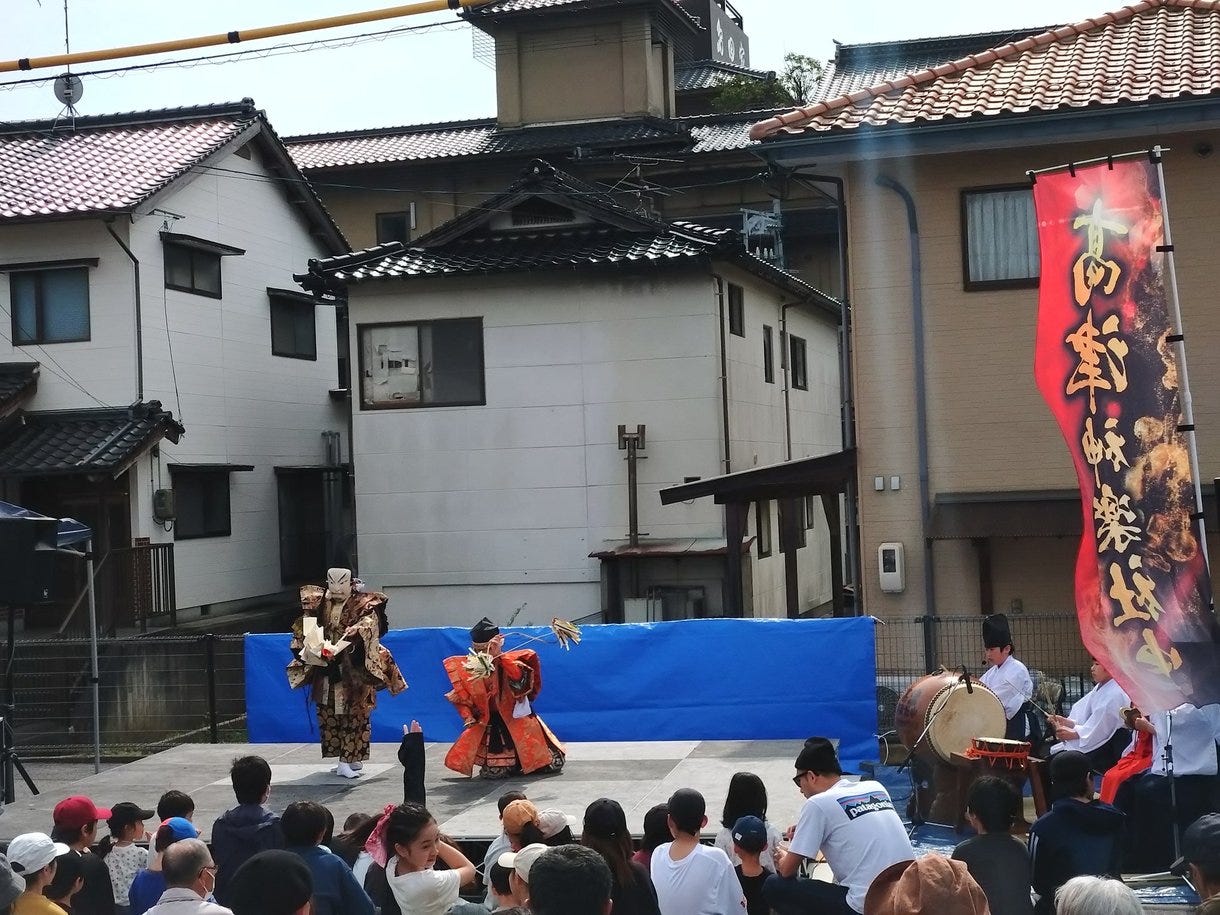Note: This post is too long for email, so please view it in the app or a browser.
In the late 1990s I visited my parents-in-law when the local community was having its autumn/harvest festival. There was a procession around the area of cute children in special yukatas banging on drums, there was boat dragged around by even smaller cute children and assisted up the hill be anxious parents. There were wandering monsters better known as the older men of the area wearing elaborate masks. It all ended up at the local shinto shrine. There were some religious rituals and more secular ones which involved photos of the children both individually and in groups.
Then after a certain amount of food onna stick and plastic cups of booze and after the kids had changed out of their yukatas, we all gathered in the shrine to watch this thing called “kagura”.
It was amazing. The beat of the big drum, accompanied by a smaller drum, small hand cymbals and a flute was weridly different but gripping. And the performance had heroes and monsters wearing intricately embroidered costumes and (for the monsters) elaborate masks just like the ones the old village guys had worn earlier. There were clouds of dry ice, flames and much intricate dancing including complex two on two sword fights. Yes there probably was a story underneath it but my Japanese was so limited I had no idea what it was - and anyway you could kind of follow along with the visuals. To be honest, the Japanese used for kagura is obscure, full of archaisms and dialect so even Japanese people from, say, Tokyo can struggle with it. It doesn’t help that much of the words are spoken into a mask which may have a microphone to pick them up but it probably isn’t working and so on…
Anyway, long story short, I was hooked.
Kagura and Kabuki
I’ve said at various times (e.g. here) that Iwami Kagura is the drunken uncle of Kabuki and that probably needs a little explanation.
Kagura (神楽) just means sacred dance and various regions of Japan have kagura rituals. But here in Western Japan, kagura evolved to having significant vocal narrative around the dance performance. If you want a modern secular comparison think ballet vs a Lloyd Weber musical like “Cats” or “Phantom of the Opera”. Iwami Kagura takes its name from the region it comes from, the old Iwami-kuni, which is western Shimane. The Eastern half of Shimane is Izumo-kuni (and not forgetting the Oki-kuni which is the Oki islands). Anyway Izumo and Iwami kaguras share similar concepts and stories - both feature the Susanoo vs Orochi story that takes place in Okuizumo for example - but Izumo kagura is sedate. The dancers move slowly and deliberately and the music is equally slow paced. It’s not really a gripping spectacle. Iwami kagura, as you can see from the video above, is different (feel free to skip to about 34 minutes in for the fire).
So if you like Iwami kagura is the loud unruly drunken brother of polite and genteel Izumo kagura. I add drunken because all the best Iwami kagura performances take place while the audience is drinking and may include some accidental cameos by “drunk ojisan” in the audience.
It is universally acknowledged that Kabuki was founded by Izumo no Okuni (出雲 阿国) who was a miko (temple maiden) at Izumo Taisha and was volunteered to go to Kyoto to dance for the toffs nobles in order to raise money for Izumo Taisha’s renovation in the 1590s. What she and the other dancers would have initially performed was Izumo Kagura. Over a decade or so she evolved that into something more popular, more secular and eventually more lewd that became known as Kabuki.
Interestingly some of the things she allegedly innovated - such as skits about local notables and gossipy asides - are moderately common in Iwami kagura performances when it is the local kagura troupe performing in front of their neighbors for the local matsuri.
Kagura Performances
The basic kagura story (enmoku 演目) goes like this:
Introduction (usually the good guy(s)). This often has people saying “So oroo” a lot then they go off stage
The bad guys show up (or if the intro was the bad guys, the good guys show up) and explain their side of things.
The good guys encounter the bad guys
There’s some posturing
There’s some fighting
The good guys win and celebrate
Some performances include the monsters running through the audience and generally grabbing small children. Said children usually love this, but some object by crying. In a couple of performances the taiko drum is used as a stand by the bad guy. In Ebisu there’s nothing other than a fisherman catching a fish and tossing candy at the audience. There are some performances where one of the performers asks questions of the audience and/or tells local jokes
This Masuda city tourism page has a brief summary of most of the common tales and this Hiroshima one has more details on a few but there are plenty of other tales that are performed.
When and where to watch
Due to the weight of the costumes, kagura is traditionally performed mainly in the colder times of the year, though these days indoor auditoria with air conditioning do remove that limitation.
If you get the chance to attend a local festival (matsuri) or event where they have a kagura performance as part of the entertainment I recommend doing so. My wife & I recently went to one such in Kitahiroshima where there was sake-tasting from various local makers, fish onna stick and other similar food and various entertainments, concluding with a kagura performance. Even better if you can find one that has the kagura in a shrine. But this can be tricky because they often aren’t widely publicized - we learned about the sake event one because we saw one of the sake makers post about it and followed the link.
If you are in the area you may see posters like the following in restaurants, Michi-no-eki and tourist information places
Typically these posters have a phone number to call to reserve tickets/get more information but often they just welcome you to show up on the day and usually someone will be willing to assist in poor English and high enthusiasm. You can also look at various kagura / tourist sites (often in Japanese but google translate & friends usually do a good job) such as links from the ones in the section below.
If you want something more organized and predictable - which to be honest is probably a better option unless you speak Japanese/have a native guide - then various places have regular Kagura events that the local tourism bodies can tell you about.
Shimane Tourism site (google translated)
Hamada (various places)
Masuda (either by the station or at the Kakinomoto Shrine)
Kitahiroshima (Kagura Monzen Tōji-mura, Yuki Lodge and Chiyoda Michi-no-eki)
Gotsu (Sanpiku Gotsu Michi no Eki)
There are also (generally later in the year - October to December) all day kagura events that take place in public auditoria in the larger towns like Gotsu, Hamada or Masuda. These are also listed at the Shimane and Kitahiroshima sites.
Finally some onsens/ryokans offer kagura performances. For example Yunotsu Onsen and Mimata Onsen - the Shimane tourism page above lists others. I recommend Yunotsu because they perform the kagura in the shrine and because it is a good place to combine seeing kagura with other tourism (such as visiting Iwami Ginzan)
Visiting the workshops
Hamada city offers group tours to two or three of the places where they make kagura costumes and masks, followed by a kagura performance somewhere. I’m not sure if they cope with individuals / small groups but the workshops themselves are certainly happy to see you and sell you some of what they make. The masks in particular are a unique (but not cheap) souvenir.
This page (google translated) lists a number of ones in the Hamada area. I have visited the Katsuro Kakita Mask Workshop (柿田勝郎面工房) and the Kagura Shop Kuwanoki (神楽ショップくわの木).
The latter is next to the Kintanosato onsen (English) which is a nice place to stay and used to offer packages with kagura at nearby Mimata Onsen. It may still do so, but I didn’t see it mentioned on the website. However if not you can almost certainly combine the two yourself because Mimata is a short drive away - just don’t drink and drive!
Iwami Kagura Notes
Miscellaneous facts that don’t really fit.
Most kagura troupes are somewhere-kagurashachu (神楽社中) but just to keep you confused some are somewhere-kaguradan (神楽団).
For the real kagura aficionado, there are a number of slight regional differences between kagura troupes. In Western Shimane (Hamada/Masuda) the rhythm is faster at 8 beats instead of 6 along the Gonokawa. Interestingly the faster beat means that some dance maneuvers are shorter (one less spin).
In Hiroshima it is more common for the heroes to not wear masks but just theatrical makeup. This is rarer in coastal Shimane where often all performers are masked. There’s also a tradition in some troupes for the good guys to start masked and end up not. But none of this is set in stone and variations happen
Traditionally kagura is an all male thing, but recently this has started to change. Some of the musicians (often the flautist) may be female and occasionally the female parts in the story are played by actual women. There are a couple of all women kagura troupes too.
Finally, most kagura is performed by adults but you will sometimes see child (teenager) troupes. These can be of varying quality but there’s never any doubt about their enthusiasm
















Wow! Those performances look awesome! We do have Ebisu dancing, catching tai, blessing watchers with his sensu and throwing candy to kids here near Tokyo. We have seen him numerous time at various wadaiko matsuri that my city hosted before the panic. I always enjoyed it and the kids love(d) it.
Have you noticed any differences in pre and post panic performances, as we have with our local Matsuri in the Kanto area?
Thanks for giving some background history too!
I see I missed quite a lot by having never visited the areas touching upon the Sea of Japan!
Regarding 社中 and 団; I would imagine 団 comes off as more ragtag while 社中 is perhaps more business like? So 団 mainly in 石見, and 社中 in 出雲 if that theory holds.
The various "onna" gave me a surprise and a good chuckle.